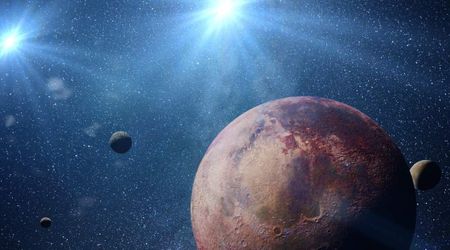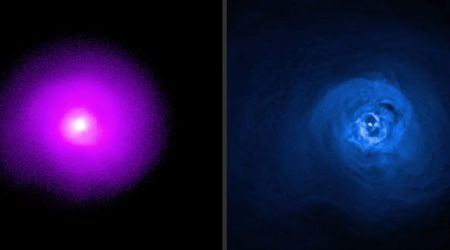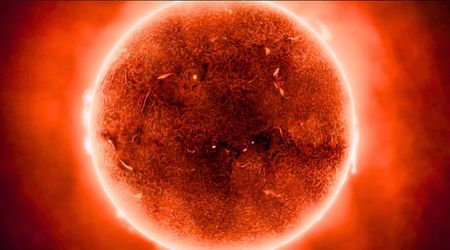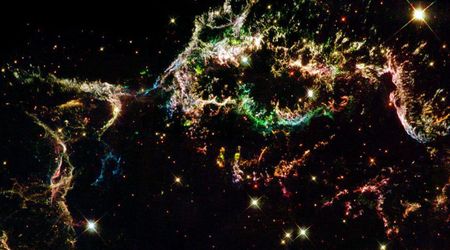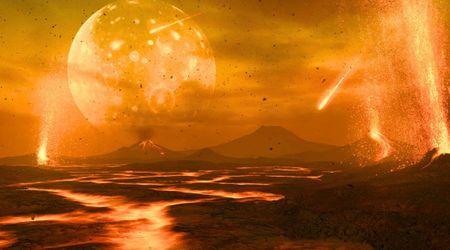Open Clusters

Planetary nebulae are shells of gas thrown out by some stars near the end of their lives. They are transient phenomenons, lasting between 30,000 and 100,000 years between formation and complete dissipation. It is likely that our own Sun will become a planetary nebula after exhausting its supply of nuclear fuel, about five billion years from now.
Generally when observing planetary nebulae use the highest power your telescope can give. Also, an OIII filter is of great use for finding small planetaries that could easily be mistaken for a star.
To identify a planetary nebula with such a filter you must repeat observations with and without the filter, and the nebula will appear to “blink on” when the filter is in place. If you don’t have a filter, another technique is using a prism that reveals the planetary nebula’s spectrum. However, the prism doesn’t work for very faint planetaries.
Because planetary nebulae have a reasonably high surface brightness, it is possible to observe most of them from moderately light-polluted locations, with telescopes of at least 150 mm.
Planetary nebulae observed with a 114-mm telescope
NGC 7009 (Saturn Nebula) is a spectacular planetary in Aquarius. At 50x is easily detectable from a star, but I didn’t manage to see its characteristic, elongated shape. You can’t miss it, it’s the brightest object in a one-degree area. Using 120x I’ve managed to see its elongated shape, but no other details.
NGC 6445 (Little Gem Nebula) in Sagittarius is small and pretty faint. It has a round shape and gets brighter towards the center. Close to the nebula, to the west, I’ve seen a bright double star.
NGC 3242 is also known as “The ghost of Jupiter”, because when seen through a telescope it has a similar diameter with that of the planet. It is easily seen at 36x, bright but with no visible details. Using 120x the round shape is more evident, but I still haven’t managed to see any details.
Using 50x NGC 7662 is easily detectable from a star, its color is slightly red. Using 120x the central hole is easily seen, it looks like a miniature version of M 57 in Lyra.
M97 (Owl Nebula) – using 120x the round shape is evident, and the light is evenly spread. Two dark portions are visible, embedded in the nebula.
NGC 7293 (Helix Nebula) is the largest planetary nebula, it is easily seen even at a power of 4x, on superb skies. Using 50x I’ve managed to see a huge circle of diffuse light. It was a difficult object for me to observe, because of the moderately light-polluted sky.
M57 in Lyra is the most famous of all planetary nebulae. At 120x its central hole is easily seen, the nebula has an oval shape and the disk is not uniformly bright. Two darker portions that seem to cut the nebulae’s disk in half are easily seen.
M76 (Little Dumbbell Nebula) is a planetary nebula in Perseus. All that I could note was a small gray area roughly 3×2 arcminutes in size. The nebula takes well high magnification, probably 120x is ideal.
NGC 6826 (Blinking Nebula) is located south of the spectacular double star 16 Cygni. At 36x I’ve almost mistook it for a star. Using 120x I’ve easily managed to see its very bright disk.
I’ve first seen NGC 6543 (Cat’s Eye Nebula) through a friend’s 200-mm telescope. It is extremely bright, at 400x the disc is easily seen. With my 114-mm telescope, the nebula can only be seen using averted vision.
M27 is a big, bright, rectangular fuzzy patch at 36x. The twin lobes of the “dumbbell” shape were detectable with averted vision. The southern lobe was somewhat smaller and brighter than the northern lobe.
Planetary nebulae observed with a 60-mm telescope
M57 is very difficult with a 60-mm refractor. At 36x it is easily mistaken for a star and the central hole is visible only with averted vision.
M27 – Round, evenly spread light. In the north and south, some dark intrusions are visible with averted vision.
